Our delicious and easy Prime Rib recipe features step-by-step instructions and tips to cook it perfectly
Looking for more simple main dishes that impress your family and friends? Try Roasting a Perfect Turkey, Boneless Leg of Lamb Roast, or Prepare and Cook a Perfect Ham.
Learn How to Cook a Perfect Prime Rib Roast Recipe & Cooking Instructions in six easy steps:
1. Prime Rib Size & Purchasing Tips
2. Dry Aging Prime Rib – Optional
3. Preparing Prime Rib Roast to Cook
4. Prime Rib Internal Temperatures
5. Prime Rib Roast Recipe
6. Carving Prime Rib Roast
Side Dishes for Prime Rib Roast
Yorkshire Pudding Recipe
Gravy, Au Jus & Sauce Recipes
Prime Rib Dinner Menus & Recipes
Comments and Photos from Readers
Perfect prime rib roast recipe just in time for the holidays!
What is a Prime Rib? A Prime Rib Roast is a very tender, flavorful, and usually an expensive cut of beef. Also known as a Standing Rib Roast, it is a popular centerpiece to a Christmas table and other festive holidays throughout the year. Prime Rib Roast is a tender cut of beef taken from the rib primal cut. The generous marbling and fatty layer are what gives this cut the distinct and juicy flavor that you are paying for, so leave it on the roast. After making the perfect prime rib roast recipe for the holidays, you will never go back to turkey again!
Want to try another Prime Rib flavor dimension? Learn how to cook Smoked Prime Rib low and slow for a succulent kiss-of-smoke flavor that melts in your mouth.
Perfect Prime Rib Roast Recipe:
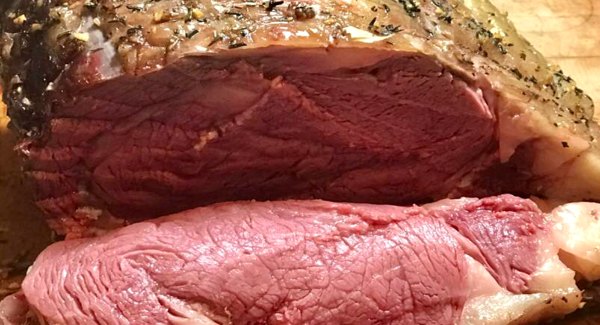
- 1 Prime Rib Roast standing rib roast at room temperature (very important)
- 2 tablespoons butter at room temperature
-
Preheat oven to 450 degrees F. Pat the room-temperature standing rib roast (prime rib roast) dry with paper towels or napkins. Smear the cut ends only of the roast with the butter.
-
Previously Frozen Roast: If your prime rib roast is frozen, let it thaw completely in the refrigerator. Remove the roast from the refrigerator about 2 to 4 hours before cooking to let it come to room temperature. Depending on the size of your roast, the time to come to room temperature may vary. I can not give you an exact time on this. Use your best judgment! -
Room Temperature: To cook evenly, the roast must not be cold - let it stand at room temperature, loosely covered, for about 2 to 4 hours. This time can vary depending on how big or small your roast is. I can not give you an exact time on this. If you do not let the roast come to room temperature, if will take longer to cook your roast, your roast won't cook evenly, and you will end up with well-done slices on the end and raw meat in the center. Use your best judgment on room temperature times! -
Do NOT salt the outside of your prime rib roast, as salt draws out moisture from the meat while cooking. You can use a prime rib rub containing other seasonings if desired, but I find it is not necessary. I know that some people do salt their prime rib roast before cooking, but trust me and do no salt - the result will be a juicy, delicious roast to serve your family and guests! -
Roasting Pan: Place the roast, ribs down or fat side up, in a heavy stainless-steel Roasting Pan or other metal roasting pan. Select a roasting pan that has sides at least 3-inches deep. (I do not recommend using nonstick pans, as these pans yield fewer of the cooked-on bits that make the tasty au jus juice or gravy.) The rib bones are a natural rack; you will not need a metal one. -
Cooking Temperatures: Sear the rib roast for 15 minutes at the higher oven temperature (450 degrees F.), then turn the oven to the lower temperature (325 degrees F.) for the rest of the cooking time. Every 1/2 hour, baste the cut ends of the roast with the fat accumulated in the roasting pan. Do Not Cover the roast. -
You will want to estimate about 12 minutes per pound of meat for the cooking time. See charts to make it easy to determine Prime Rib Roast Cooking Times. About 45 minutes before the estimated end of the roasting (bake) time, begin checking the internal temperature (use a good instant-read digital meat thermometer). Play it safe and start checking early, as you do not want anything to go wrong. This is even more important if you are adjusting for High Altitude Baking. -
If you ignore every other bit of advice I have given, please pay attention to this: For a perfectly cooked rib roast, invest in a good meat thermometer. Internal temperature, not time, is the best test for doneness and you do not want to blow this meal!
-
This is the type of cooking and meat thermometer that I prefer and use in my cooking. I get many readers asking what cooking/meat thermometer that I prefer and use in my cooking and baking. I, personally, use the Thermapen Thermometer shown in the photo on the right. To learn more about this excellent thermometer and to also purchase one (if you desire), just click on the underlined: Thermapen Thermometer.
-
When checking the temperature of your prime rib roast, insert meat thermometer so tip is in thickest part of beef, not resting in fat or touching bone. Cook until rib roast reaches an internal temperature of 120 degrees F. (or your desired temperature). See chart to determine Prime Rib Roast Internal Cooking Temperatures for rare, medium-rare, medium, medium-well and well-done. Remove from oven, cover loosely with aluminum foil, and let sit approximately 15 to 20 minutes. Cutting into the meat too early will cause a significant loss of juice. Do not skip the resting stage. -
Residual Heat or Carry-Over Cooking: Remember, the rib roast will continue to cook as it sets. The internal temperature will rise to 125 degrees F. to 130 degrees F. (medium rare) in approximately 15 to 20 minutes. If allowed to rest as long as an hour, the internal temperature will rise even higher. So, pay attention to how long you let the cooked prime rib roast sit. -
Holding Cooked Rib Roast: To hold cooked roast until serving time, immediately turn off the oven and leave the door ajar after removing roast. Let roast sit 15 minutes on the counter and then return roast to the oven, door closed, for up to an hour or even 2 hours for the biggest roasts. Check the temperature every 15 minutes. If will rise approximately 10 degrees F. at first, then gradually subside.
-
If Using a Convection Oven: Using a convection oven can cut as much as 25% off the cooking times listed for the regular oven. It is also easier for your roast to dry out and cook too much in the convection oven. Watch the roast carefully and please use a cooking thermometer to know when the roast is done and should be taken out of the oven.
Watch the video to learn how to make perfect prime rib
What Size of Prime Rib Roast to Buy?
A common question people ask is “How much prime rib roast should I buy per person?” A full prime rib roast is seven (7) ribs, close to 15 to 18 pounds, and enough to feed a crowd of 14 or more people (depending on how big of eaters they are). The term “standing” means the bones are included in the roast, thus the roast can stand by itself. A prime rib roast comprises of seven ribs starting from the shoulder (chuck) down the back to the loin.
Do not even bother with less than a three-rib roast, any less than that is not a roast but rather a thick steak and would be better treated as such. For a generous serving of roast, figure on two people per rib. That means if you plan to serve:
two (2) people – one (1) rib roast
six (6) people – three (3) rib roast
eight (8) people – four (4) rib roast
ten (10) people – five (5) rib roast
twelve (12) people – six (6) rib roast
fourteen (14) people – seven (7) rib roast
How To Purchase A Prime Rib Roast:
First of all, let’s dispel a common myth: The term prime rib does not necessarily indicate a rib roast is a prime grade, and in most cases, it probably is not. Prime is an official USDA designation of grade and few supermarkets display this elite grade of beef because of its high cost relative to other grades. Prime Rib has become more a style of cooking the meat than of the quality of the cut. This is also why you rarely see this cut labeled as Prime Rib at the supermarket but rather as Beef Bone-In Rib Roast because the USDA requires that a cut of beef must be officially graded as Prime before it can be so labeled.
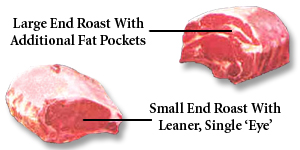 Insisting you get a rib roast that is actually prime grade is well worth the effort for this perfect prime rib roast recipe. Less than 2% of all industry beef merits this designation from the USDA. You will likely have to ask your butcher to special order a true Prime grade rib roast for your occasion, but when the forks hit the plate, your family and guests will notice the difference and then some!
Insisting you get a rib roast that is actually prime grade is well worth the effort for this perfect prime rib roast recipe. Less than 2% of all industry beef merits this designation from the USDA. You will likely have to ask your butcher to special order a true Prime grade rib roast for your occasion, but when the forks hit the plate, your family and guests will notice the difference and then some!
One universal truth of the meat world is that fat means flavor! But of course, many prefer a leaner cut, and the whole beef rib (where rib roasts are portioned) was kind enough to offer both. The whole piece is divided roughly in half, a large end and a small end. The large end is defined by the presence of more fat pockets throughout the meat, while small end rib roasts contain a single, intact muscle and are leaner. Whether one is better than the other is really never more than a matter of personal taste and how much fat your diet will tolerate. In choosing between them and determining which will better suit your palate, it may help some of you to know that the small end is where a butcher produces boneless rib eye steaks, and the large end yields Delmonico steaks.
Grading Cuts of Beef:
Does the grade of the meat make much of a difference? You bet it does – The better the grade of beef, the less you have to do to it! The higher the USDA grade, the more money you will pay.
The USDA’s grading system gives a good way to assess quality. The grading designations are largely determined by the amount of visible fat that’s streaked throughout the muscle tissue, called marbling. Beef that’s richly marbled gets a higher grade; it is more tender, juicy, and flavorful because the intramuscular fat melts and bastes the flesh during cooking.
Prime – The highest grade in the U.S. meat grading system. Prime has the most marbling and is produced in limited quantities. Prime beef is most commonly sold in fine restaurants and specialty meat markets.
Choice – Choice has less marbling than Prime but more than Select. It is typically found in the service meat case at your local grocery store.
Select – Select has the least amount of marbling of the top three grades, making it leaner but possibly less tender, juicy or flavorful than Prime or Choice. Select is most commonly found in the self-service meat case at your local grocery store.
Beware of marketing deceptions where some grocery stores or supermarkets may try to fool an unsuspecting consumer by using the words “prime”and “choice”without being attached to the official “USDA shield.” Unless prime and choice carry the USDA label, what you are buying may not be the real thing.
Size of Prime Rib Roast To Purchase: A whole standing rib roast (prime rib roast) consists of ribs 6 through 12. Most GOOD butchers recommend that you request a rib roast from the small end toward the back of the rib section, which is leaner and gives you more meat for your dollar. This cut is referred to as the first cut, the loin end, or sometimes the small end because the meat and ribs get larger as they move up toward the shoulder. I do NOT recommend purchasing a boneless rib roast, as roasting with the bones adds flavor. But, if you do purchase a boneless prime rib roast, cook using the same guidelines as a roast with ribs. Usually, the weight is figured without the bones. If in doubt, weight your roast before cooking it.
Package Date: Be sure and check the date the prime rib was packaged. This is an indicator as to how long it has been sitting around in the store. Look at the color of the prime rib; it should have a bright red color and no dry or brown edges. Check for any damage to the packaging and wrapping.
The Bones: Have the butcher cut off the chine bones from the bottom of the roast and the rib bones from the meat just along the bone line but do not discard them. They can be cut off in separate pieces or the chine bones can be cut off as one piece with the rib bones. Have the meat placed back on the rib bones and wrap them along with the chine bones to take home to cook along with the roast. Your butcher will also tie the bones back on the roast if you ask. Having the bones cut away from the meat before cooking will make carving the finished prime rib a lot easier.
Back to the top
How To Prepare Prime Rib Roast:
Photos in this section by Perrin Kliot, Berkerley, CA.
Fat Cap or Lid: The fat provides the flavor and what you are paying for with prime rib, so leave it on. Some rib roasts are sold with the thick fat cap on top of the meat intact, and some are trimmed. I prefer to have most of the fat cap intact and trimmed to an even layer approximately 1/4-inch to 1/2-inch thickness. Most butchers will trim the fat down for you.
You could trim the trim the fat yourself by using a sharp thin knife to trim the fat on the top of the roast to 1/2-inch thickness. Trim roast of excess fat, but not the thin layer of fat (the fat cap or lid) the butcher leaves on the roast to protect and baste it while it cooks. Excess fat means any fat more than one (1) inch thick. So – it is up to you if you want the fat cap left on your prime rib or if you want it removed.
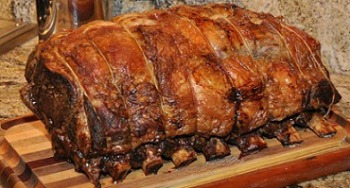
First photo shows fat cap intact on an uncooked prime rib roast before cooking – Photo by the Barkers in West Bloomfield, MI
Second photo show fat cap intact on a cooked prime rib roast – Photo by Perrin Kliot, Berkerley, CA.
Tying Up Prime Rib Roast: It is important to tie the prime rib before roasting. If left untied, the outer layer of meat will pull away from the rib-eye muscle and overcook. To prevent this problem, tie the roast a both ends, running the cooking twine parallel to the bone. Most butchers will tie your rib roast for you – so ask the butcher!
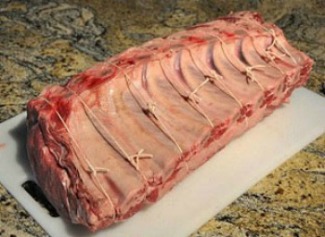
Tie the roast at both ends, running the cooking twine parallel to the bone. Tie the meat to the rib bones and include the chine bones at the bottom of the prime rib roast. Tie around the meat and ribs in between the bones on each end, making sure to tie the chine bones to the meat also. Also, tie around the meat and bones in the center of the prime rib.
Back to the top
Optional – Dry Aging Prime Rib Roast:
Dry Aging is optional, but if you have the time and the space in your refrigerator, you can dry age the raw prime rib roast for several days to bring out additional flavor and produce a more buttery texture in prime rib roast (aging allows the natural enzymes to break down some of the protein in the meat). Dry-aged beef can be expensive to purchase and hard to come by. Some top-quality butchers will offer already dry-aged prime rib roasts for sell. If you can find one and can afford one (as they are pricey), purchase the roast.
A food safety note: Home refrigerators are not as consistent or as cold as commercial meat lockers. Before aging you rare prime rib roast at home, get a Refrigerator Thermometer and be sure your refrigerator is set below 40 degrees F.
How to dry-age raw prime rib roast at home – The good news is that you can dry-age beef at home:
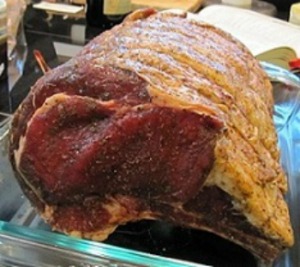
Only the top grades of beef can be dry aged successfully. Use USDA Prime or USDA Choice from the best meat source in your area. Buy a whole prime rib roast or rib-eye roast. Unwrap the beef (do not trim), rinse it well with cold water, allow the meat to drain, and pat then pat the meat dry with paper towels.
Wrap the roast loosely in a triple layer of immaculately clean cheesecloth or plain white cotton dish towels (this will help to draw moisture away from the meat) and set it on a rack over a rimmed baking sheet or other tray. Place the wrapped roast on the bottom shelf of the refrigerator (which is the coldest spot in your refrigerator). Refrigerate for 7 to 10 days (the longer the beef ages, the tastier it gets). After the first day, carefully unwrap and then rewrap with the same cheesecloth to keep the cloth fibers from sticking to the meat.
When ready to roast, unwrap the meat and, with a sharp knife, shave off and discard the hard, dried outer layer of the meat. Shave away any dried areas of fat, too, but leave behind as much of the good fat as possible. NOTE: There can be much waste as the dried and sometimes moldy meat needs to be trimmed away before cooking and eating it.
Prime Rib Roast Cooking Internal Temperature Chart:
The chart below is only a guide. You must rely on an accurate Meat Thermometer and start taking temperatures about 45 minutes before the end of the estimated roast time. Reminder: Instant-read thermometers are not meant to be left in the roast during the cooking process.
What constitutes rare and medium-rare cooked meat?
To satisfy government home economists, the Beef Council says rare beef means an internal temperature of 140 degrees F. Well, that is ok if you like well-done and dry meat. If you like moist, rosy meat (like I do), rare begins at an internal temperature of 120 degrees F. and starts to become medium rare at 125 to 130 degrees F. To cook your meat properly, you must purchase and use a good instant-read digital meat thermometer.
 This is the type of cooking and meat thermometer that I prefer and use in my cooking. I get many readers asking what cooking/meat thermometer that I prefer and use in my cooking and baking. I, personally, use the Thermapen Thermometer shown in the photo on the right. To learn more about this excellent thermometer and to also purchase one (if you desire), just click on the underlined: Thermapen Thermometer.
This is the type of cooking and meat thermometer that I prefer and use in my cooking. I get many readers asking what cooking/meat thermometer that I prefer and use in my cooking and baking. I, personally, use the Thermapen Thermometer shown in the photo on the right. To learn more about this excellent thermometer and to also purchase one (if you desire), just click on the underlined: Thermapen Thermometer.
Also, learn How To Test and Calibrate a Cooking or Meat Thermometer.
How To Check Oven Temperature – Oven temperatures are not always correct. In fact, they can often be off by 25 to 50 degrees F. The will seriously affect the baking time of your prime rib (standing rib roast).
To check the temperature of your oven, place an oven thermometer on the center rack and heat the oven for 15 minutes at 350 degrees F. If, after 15 minutes, the oven temperature reads higher or lower than your oven setting, adjust your oven setting for your prime rib baking and for all your future baking.
Approximate Prime Rib Cooking Time until Internal Temperature reaches 125 degrees F:
1 rib (2 to 2.5 pounds) – 22 to 24 minutes
2 ribs (4 to 5 pounds) – 60 to 70 minutes
3 ribs (7 to 8.5 pounds) – 1-1/2 to 1-3/4 hours
4 ribs (9 to 10.5 pounds) – 1-3/4 to 2-1/4 hours
5 ribs (11 to 15 pounds) – 2-1/4 to 3 hours
6 ribs (15 to 16 pounds) – 3 to 3-1/4 hours
7 ribs (16 to `8.5 pounds) – 3-1/4 to 4 hours
Beef Roast Cooking Internal Temperatures:
Rare – 120 to 125 degrees F. – center is bright red, pinkish toward the exterior portion
Medium Rare – 130 to 135 degrees F. – center is very pink, slightly brown toward the exterior portion
Medium – 140 to 145 degrees F. – center is light pink, outer portion is brown
Medium Well – 150 to 155 degrees F. – not pink
Well Done – 160 degrees F. and above
High Altitude Baking: Above 2,500 feet, the atmosphere becomes much drier. The air has less oxygen and atmospheric pressure, so cooking takes longer. Use the sea-level time and temperature guidelines when oven-roasting beef, as oven temperatures are not affected by altitude changes. Allow additional cooking time for your prime rib roast at high altitude. I can not give you the exact cooking time. Using a cooking thermometer is the only way to measure whether your roast has reached a safe internal temperature. In a high-altitude environment, it is easy to overcook the meat.
Photo on left – Prime Rib almost done – just 1 degree to go for rare.
Photo on right – Prime Rib cooked to perfection!
How to Carve Prime Rib Roast:
Use a long, thin, sharp knife. Sharpen you carving knife, if necessary, using either a sharpening rod or stone.
Steel Sharpening Rod – To use a Steel Sharpening Rod or Steel pull the edge down and across the rod, holding the carving knife at a 22-degree angle. Repeat this process anywhere from 5 to 10 times.
Sharpening Stone (whetstones) – To use a Sharpening Stone (whetstones), hold the carving knife at a 10- to 15-degree angle to the stone. Push back and forth in smooth, steady strokes.
(1) Place the cooked prime rib on a large Meat Cutting Board with a well at one end to hold the juice. Remove the cooking twine that is tied around the roast.
(2) Use a carving fork to hold roast in place. Turn the platter to where the rib bones are on your left, if you are right-handed, and on your right if you use your left hand to carve.
(3) Using your sharp carving knife, make one cut to slice off the chine or feather bones (the large-end bones) to sever meat from bones in one piece. Note: Save the bones for nibbling on later or for making a delicious Beef Stock to use in soups, stews, and pot roast recipes. You could also save the bones to make a pot of Caldo de Res (Mexican Beef Soup).
(4) Set roast cut-side down. Slice the meat across the grain to the thickness you prefer.
Back to the top
Side Dish Recipes:
Learn the essential and classic side dish recipes that go well with a prime rib roast. We have provided the must-have sides to dress up your perfect prime rib roast recipe, including making either a gravy or au jus sauce from the meat drippings. You can also use the meat drippings for Yorkshire pudding pop-over pastry and, do not forget a side of horseradish or blue cheese sauce. We have also listed some of our favorite vegetable side dishes for potatoes, spinach, green beans, and corn.
How To Make Prime Rib Gravy:
Remember – Gravy is different than Au Jus Juice (see Au Jus Juice below).
After the perfect prime rib roast recipe (standing rib) is done, remove from the oven and remove from the roasting pan. Place the cooked prime rib on a large Meat Cutting Board with a well at one end to hold the juice.
Place roasting pan over two (2) burners on the stove over medium heat (always make the gravy in the same pan you used to roast the prime rib roast).
Skim and discard any excess fat from the juices in the roasting pan. Using a heavy spoon, scrape all the dark drippings and any crunchy bits from the sides and bottom of roasting pan.
Ingredients:
Use 3 tablespoons liquid fat (fat is in the drippings left in the bottom of your roasting pan)
3 tablespoons all-purpose flour
2 cups of liquid (meat juices/drippings, or broth, vegetable juice, bouillon, wine, and/or water)
In a separate container with a lid, shake together all-purpose flour and about 2 cups cool water. This is called a slurry. Adding the thickener (flour) in this way helps to prevent lumps from forming.
Preparation:
Once the drippings in the pan are lightly bubbling, slowly add the slurry mixture to the gravy pan, stirring constantly with a wire whisk. If it starts to thicken, immediately stop adding the remaining slurry. You may not need to use all the slurry, depending on how much or little drippings were left in the roasting pan.
If lumps do develop, you should be able to use a wire whisk to remove them. If all else fails and you can not remove the lumps, just place mixture in your blender or food processor and process until smooth.
If your gravy is too thick, add additional liquid, stirring constantly. Season to taste with salt and pepper.
Au Jus Juice Recipe:
Au Jus is a French term meaning “with juice.” The term is used to describe the serving of meat, most often prime rib roast, surrounded in or served with a container of the natural juices that were produced as drippings while the meat was being cooked. It is not thick like a typical sauce or gravy. Also, check out my web page on Beef Au Jus – Au Jus Beef Juice.
While the cooked prime rib roast is standing or resting for the required resting period, make the “au jus” sauce.
IMPORTANT: Making Au Jus is more of a technique and not a recipe. You will have to do this by feel or guesswork. It depends on how much juice is left in your pan (plus the juice from slicing the prime rib roast), and how many people you will be serving.
Ingredients:
Beef juices from cooked perfect prime rib roast recipe
Beef broth/stock*
Red wine (of your choice)**
* The au jus will only be as good as your beef stock (and also the red wine you use), so it is recommended that you use homemade Beef Stock, if possible. If you must use canned stock, buy the best you can find, but forget about using salty, artificially-flavored bouillon cubes.
** I like to add some of the same red wine that I will be serving with the meal.
Add your beef broth and/or wine according to how much Au Jus you think you will need for each person being served. I wish I could give you exact directions, but it is impossible to have an exact recipe for this.
Preparation:
Pour off all but 2 tablespoons of the fat (leaving the beef juices in the pan) from the roasting pan and discard the remaining fat (or reserve if making Yorkshire puddings).
Place the roasting pan on two (2) burners on medium heat. Add the beef stock and stir and scrape to release any browned bits in the pan. Add red wine of your choice. Bring mixture to a boil and cook until the stock is slightly reduced, about 5 minutes. NOTE: Au jus is not thick like a typical sauce or gravy. Season to taste with salt and pepper.
Transfer to a gravy boat or serve in small individual containers for each guest.
Leftovers: Use any leftover Prime Rib and Au Jus for making French Dip Sandwiches for your family the next day. So good!
Yorkshire Pudding Recipe:
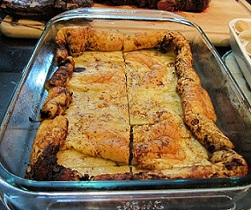
A traditional English side dish to Prime Rib Roast is Yorkshire Pudding, a puffy pop-over like pastry. Yorkshire Puddings, fresh from the oven, should be well-risen and golden brown with a crisp exterior and soft middle.
Ingredients:
3/4 cup all-purpose flour
1/2 teaspoon salt
3 eggs, room temperature
3/4 cup milk, room temperature
1/2 cup pan drippings from roast prime rib of beef (beef juices and oil)*
* If you do not have enough pan drippings, add melted butter.
Preparation:
At least two (2) hours or overnight before you will need this Yorkshire Pudding batter, prepare the batter (minus pan drippings), and place in the refrigerator. Yorkshire Pudding is cooked after you have taken your cooked prime rib roast out of the oven and you are letting it sit for the required resting period.
In a large bowl, sift together the flour and salt; set aside.
In another bowl, beat together the eggs and milk until light and foamy. Stir in the prepared flour/salt mixture just until incorporated and smooth. The batter will be like a very thin pancake batter. Cover bowl with plastic wrap and refrigerate at least two (2) hours (for best results, refrigerate overnight).
Cooking Yorkshire Pudding:
Traditionally Yorkshire Pudding is made in one large dish or your meat roasting pan and cut into wedges. For individual servings, I have found it is much easier to prepare them in muffin tins or popover pans. You be the judge of how you would like to cook and serve them. Also check out my web page on making Yorkshire Pudding.
After you take your cooked prime rib out of the oven, increase the oven temperature to 450 degrees F.
Pour the cooked prime rib meat drippings into your baking pan or muffin tins of choice. For a popover version, use popover pans or muffin pans, putting at least 1 teaspoon of meat drippings in the bottom of each well
Place the pan or pans in your oven and get the drippings smoking hot (about 5 minutes). Carefully take the hot pan/pans out of the oven. The fat in the popover or muffin tins should be almost smoking.
Remove the prepared cold batter from the refrigerator. Whisk the batter thoroughly to break down any lumps and add some additional air.
Quickly pour the batter into the hot pan/pans on top of the hot drippings. NOTE: If using popover or muffin pans, fill 1/3 full. The fat should sizzle when you pour the batter. Work quickly, so you do not lose all the oven heat.
Put the pan back in oven and cook until puffed and dry, approximately 15 to 20 minutes. Do not open the oven door during baking.
Remove from oven and serve hot with your Prime Rib Roast.
Makes approximately 6 individual popovers (depending on size of pans) or 1 large pan.
Sour Cream Horseradish Sauce Recipe:
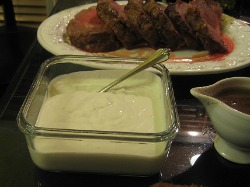
This is my favorite sauce to use with prime rib
1/4 to 1/2 cup prepared horseradish (according to your taste)
1 pint (2 cups) sour cream
2 tablespoons fresh-squeezed lemon juice
1 teaspoon salt
Directions:
In a medium-sized bowl, combine horseradish, sour cream, lemon juice, and salt; thoroughly mix. Refrigerate until ready to serve. Can be made 2 days in advance. Cover and refrigerate.
To serve, pass the horseradish sauce on the side.
Makes approximately 2 1/2 cups.
Garlic Blue Cheese Sauce Recipe:
3/4 cup heavy cream
1 medium garlic clove, thinly sliced
6 ounces blue cheese, crumbled
Freshly ground black pepper
In a medium-sized saucepan over medium-high heat, bring cream and garlic just to a boil. Lower heat and simmer until the cream coats the back of a spoon, approximately 5 to 10 minutes. Remove from heat.
Stir in the crumbled blue cheese. Season to taste with the pepper. Can be made 2 days in advance. Cover and refrigerate. Bring to room temperature before serving.
To serve, pass the Garlic Blue Cheese Sauce on the side.
Makes approximately 2 cups.
Apple Horseradish Sauce Cream – Low Fat:
1/4 cup grated tart apple
1/4 low-fat plain yogurt
1/4 cup light mayonnaise
1 teaspoon Dijon mustard
1 tablespoons prepared horseradish
In a medium-sized bowl, combine apple, yogurt, mayonnaise, Dijon mustard, and horseradish.
NOTE: Can be made 2 days in advance. Cover and refrigerate.
Makes approximately 2 1/2 cups.
 Some family favorite side dishes to serve with Classic Prime Rib:
Some family favorite side dishes to serve with Classic Prime Rib:
Prime Rib Roast Dinner Menus & Recipes
Prime Rib Roast Recipes:
Prime Rib Roast with Balsamic Glaze
Standing Rib Roast with Rosemary-Thyme Crust
New! Smoked Prime Rib
Prime Rib Roast Menus:
If you are looking for Prime Rib Roast menu ideas for Christmas or another holiday meal, we have provided two great dinner menu options below. Prime Rib Roast always makes a meal exceptional when it is served to your family for Christmas dinner or another special holiday occasion.
Five-Course Christmas Prime Rib Dinner Menu & Recipes
Six-Course Best Christmas Prime Rib Dinner Menu & Recipes
I welcome your photos and comments on cooking your Prime Rib Roast. If you have the time, then please take the time to share with others. Contact Linda Stradley.
Comments and photos from Readers:
Check out the comments and photos sent to me in 2007 to 2016. As this web page had gotten too large, I had to place the comments on an additional page. Please also check them out.

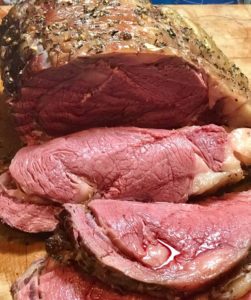
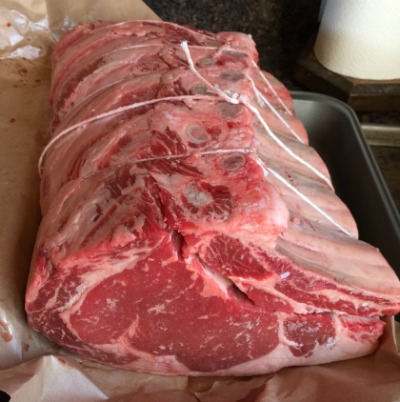
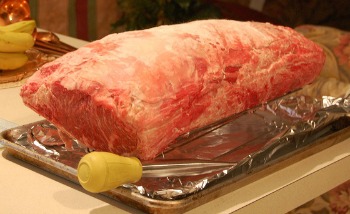
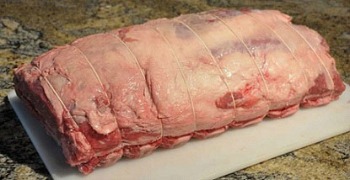
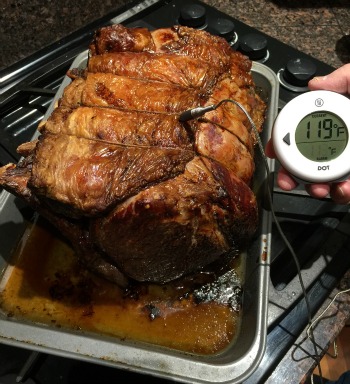
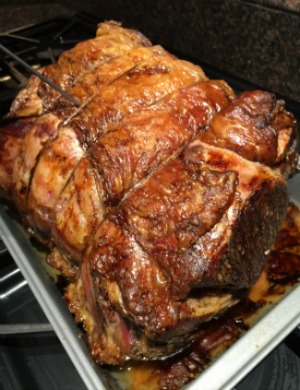
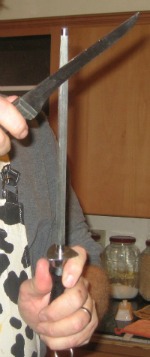
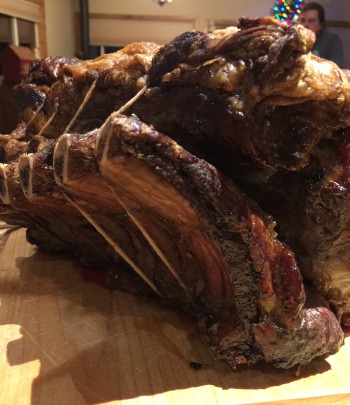
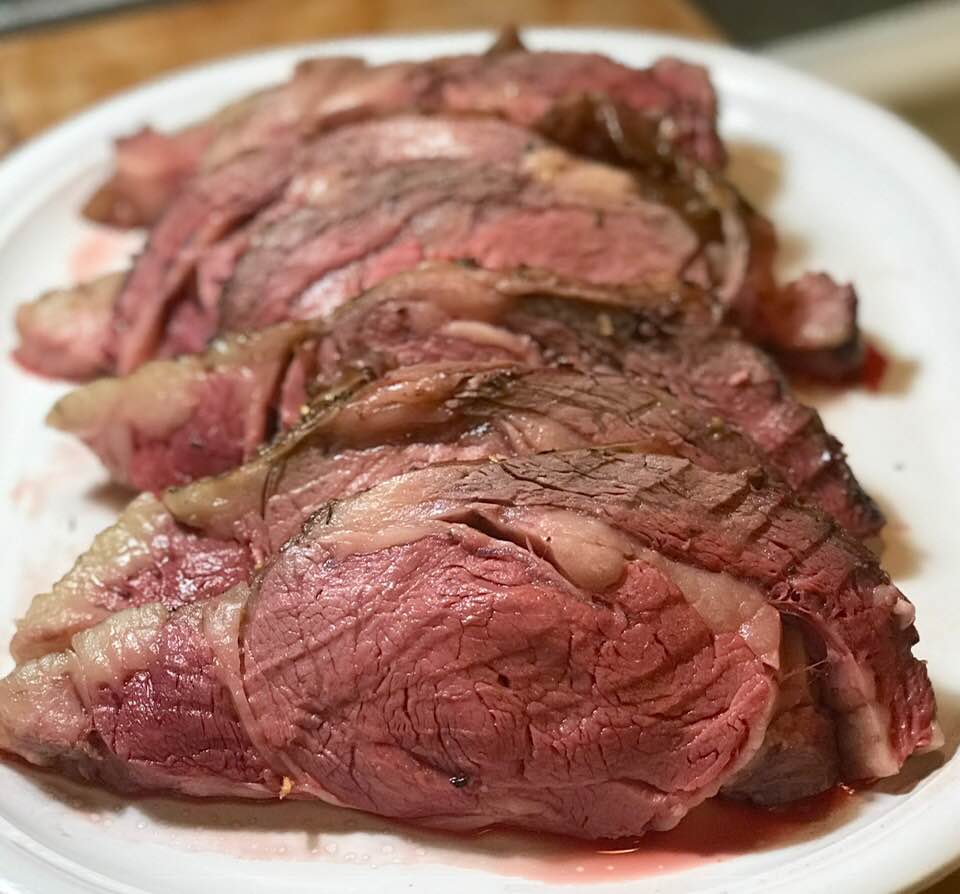


114 Responses to “Perfect Prime Rib Roast Recipe – Cooking Instructions”
David
Nicely done. Very very organized.
margaret
Very – very – good article – read all
Connie Schwab
Can you cook in an electric roaster? If yes, what, if a ything, must be done differently?
Linda Stradley
Yes you can. I personally have not used an electric roaster myself. The below comments are from a reader who did use one. I hope this helps you:
Using Electric Roasting Pan:
I really enjoyed reading your website about buying, preparing and cooking a rib roast. I plan on cooking one on Christmas Day. Here is my question for you. I have a GE Roaster. It’s a like a mini oven that sits on your table. I have cooked Thanksgiving turkey in it several times and just plain old baked chicken. They both come out delicious! And the turkey usually cooks in a shorter amount of time than is suggested for regular oven cooking. I want to make my roast in this oven. Do you see any problems with that? It will free up my oven for all the other goodies I plan to make. T hanks so much in advance for your reply. Again, I loved your website and will have to go read everything else on it! – Robin Sherlock (12/23/09)
What’s Cooking America response: I have to be honest and tell you that I have never used an electric roaster for cooking anything. If the roaster cooks in a shorter time period, you will have to be careful that it doesn’t dry out your prime rib roast. Please, please use a cooking thermometer to check your roast during the cooking process so as to know how fast the temperature is rising. Remove the prime rib from the roaster at 120 degrees F. Let me know how your prime rib turns out using the electric roaster. I’m sure other people will be interested in this technique. I would like to post your findings on my web page. – Linda Stradley
Feedback from Robin (12/26/09):
I am so sorry I forgot to take pictures! My kitchen was an absolute zoo at the time I took the roast out. But I wanted to let you know that we cooked the 18 lb roast in my GE oven roaster and it came out spectacular! It fit just perfect! And the roaster has a metal rack with handles that we placed the roast on top of to make it easier to lift that bad boy out when done. I actually bought two digital-read thermometers because when I tested the first thermometer and it didn’t reach 212 degrees in boiling water, so I went out and bought the other one. That one worked great! I started checking the roast early on because I was nervous cooking it in the roaster. We took it out at exactly 121 degrees. It was beautiful. I wanted to carve it the way you instruct on the website but I didn’t have a great knife and the roast was so big. So my father-in-law just started slicing it up! It was great though! I also made your sour cream horseradish and everyone loved it. And I made your au jus. It was delicious! Oh yeah – just before I was going to start preparing the roast with my seasonings, I realized it wasn’t tied up, so I marched it into my grocery store on a cookie sheet wrapped in a huge bag and made them tie it up! Thank you so much for your website!
ladyllama
Robin what temperature did you cook your prime rib at low – at 225 or 325? I also have a ge cooker and would like to cook the 18 lb rib in it.
Larry Gross
My son wants to smoke the prime rib roast. Your thoughts on the idea, prep, wood, etc please. Thank you
Larry
Linda Stradley
I have never smoked a prime rib roast myself. Hopefully some of the readers can help you.
Angela Koole
We smoke our prime rib for Christmas every year and they are wonderful! We use Mesquite wood but Apple would work as well.
Rick Rigler
Hi Linda – in your instructions I can’t be sure what is the actual cooking temperature for the Prime Rib Roast. At one point you do say set the oven at 350, but at the time you are discussing the accuracy of the actual oven temperature.
I see other recipes that call for cooking the roast at a low (200) temp the entire time, to assure even amount of doneness from edge to center; also other recipes that call for cooking at a very high temp for a short time then at a drastically lower temp for the remaining time. Will you share your thoughts on those methods?
Kind regards,
Rick Rigler
Linda Stradley
Cooking Temperatures: Sear the rib roast for 15 minutes at the higher oven temperature (450 degrees F.), then turn the oven to the lower temperature (325 degrees F.) for the rest of the cooking time. Every 1/2 hour, baste the cut ends of the roast with the fat accumulated in the roasting pan. Do Not Cover the roast.
About 45 minutes before the estimated end of the roasting (bake) time, begin checking the internal temperature (use a good instant-read digital meat thermometer). Play it safe and start checking early, as you do not want anything to go wrong. This is even more important if you are adjusting for High Altitude Baking.
Sheryl Meyers
I followed your recipe to the letter and my first prime rib roast turned out perfect. I am so glad I could a website that said dont use salt. Thank you so munch for all the tips and directions you put her. I am a successful cook on this recipe! Hope your New Year is all you expect and want it to be.
Sandi
Can i use a crock pot to make the prime rib? Thank you!
Linda Stradley
I just can not imagine cooking an expensive prime rib roast in a crock pot.
Diane Asoyuf
Tks for all this info. Very informative. am trying this tomorrow
Judy
Great instructions. More detailed than I have seen. My husband wanted a prime rib for his birthday. Your info included cooking time for a smaller roast. It turned out perfectly!
Scott
I first stumbled across this recipe a couple of years ago when I made my first prime rib for a Christmas dinner. I have come back to this recipe and guide several times since them. This is THE definitive guide for making a prime rib at home, end of story. I have tried other recipes, but this is by far the best. Thank you for putting together such a helpful resource.
Bigray
I followed these instructions and mothers day for my wife was over the top. Thanks for being there for my family.
Rosslynn
I just tried this and it turned out awesome…as good as any I have had from any restaurant. A must try.
casey
I am cooking a 7 rib roast and I am planning on doing classic method. When i pull it out of the oven at 120 (Bc we prefer rare to med rare) do i need to let it sit longer than 15 minutes because its a bigger roast? Or can we carve it after 15-20 minutes? I’m just worried about the juices. Thanks !
Whats Cooking America
Your Prime Rib should be just fine to carve after resting for 15-20 minutes. Check the temperature after it rests to make sure it achieves the internal temperature you desire for rare to medium-rare before carving. If you decide to let the Prime rib sit longer than 20 minutes, keep in mind the internal temperature will keep rising. I would recommend checking your meat temp if it sits longer.
Diva
Can skewers be used instead of twine to hold the prime rib in place?
Linda Stradley
I, personally, would never use skewers on any roast. Poking holes in the beef allows the juices to flow out during cooking.
Michelle P
Hi, it is Thursday afternoon and I just pulled my 22 lb prime rib roast out of the freezer. I need to cook it Sunday. I don’t think it will defrost in the fridge in time..will it be ok to defrost in the sink? It is vacuum sealed..your guidance please?
Linda Stradley
First, you still have a couple of days to try to thaw your prime rib roast in the refrigerator. If it still is not thawed by Saturday night, I would do the following:
I would put it in a sealable, leak-proof plastic bag, squeeze our as much air as possible out of the bag (you do to want air and water to be able to get inside the bag). Submerge it in cold tap water, using either a sink or a cooler (I would probable use a cooler). Change the water throughout the night as it becomes warmer.
Gamma
Wonderful and informative !
Please comment on the cooking of rib roast for an hour at 375 degrees, then turning oven off (allowing roast to remain in the oven) to then turn it back on at 375, 30 to 40 minutes prior to then taking it out and allowing to sit while finishing up other prep for meal…
Thanks, Gamma
Linda Stradley
This is the way I cook my prime rib roast:
Cooking Temperatures: Sear the rib roast for 15 minutes at the higher oven temperature (450 degrees F.), then turn the oven to the lower temperature (325 degrees F.) for the rest of the cooking time. Every 1/2 hour, baste the cut ends of the roast with the fat accumulated in the roasting pan. Do Not Cover the roast.
Steve
I am going to cook a rib roast rare, what if one of my guests would like the portion well done?
Linda Stradley
Remember that the center of the cooked prime rib will be cooked more than the ends.
Jo
The ends will be more well done than the center.
Sonnie
If the ends aren’t well done enough then cook(bathe) it to the desired temp in au jus over a very low simmer.
Reta
I plan on cooking my standing three rib roast for the first time on Christmas. Would I be able to use my Corning ware roaster in place of a metal pan?
Nancy
Shouldn’t be a problem, go for it, and Merry Christmas!
Carolyn Lundy
Can you cook a prime rib in an Instapot?
Whats Cooking America
Not everything is meant to be cooked in an Instant Pot/pressure cooker. I would not recommend cooking an expensive prime rib roast or nice steak in an Instant Pot or pressure cooker. A prime rib roast should be carefully monitored for internal temperature with a digital thermometer so it reaches your preferred doneness of rare, medium rare or medium. Pressure cookers work their best to cook and tenderize tough cuts of meat like pot roast, brisket or pork butt.
Alice
The very BEST (! ) use of ribs cut off a prime rib roast is Beef Ribs Diablo. Slather the cut side of the ribs with butter and then with Dijon mustard. Add a 1/4″ thick layer of bread crumbs and drizzle with olive oil. Put back in the hot oven for 15 – 20 minutes.
Dave W
Looks good!!!!! Family loved it
Beth Andre
Do you count the 15 minutes searing at high temp in the total cooking time per pound? My roast is small, just for 4 people and I don’t want to overcook it. Thanks.
Wendy
We followed the recipe but our roast did not cook in the amount of time listed. It seared beautifully for the first 15 minutes. When we turned the oven down to 325 we had to leave the roast in the oven for an extra 45 minutes and it still was closer to medium rare than to medium. 12 minutes per pound was definitely not enough cooking time.
Linda Stradley
Remember to use an internal thermometer for determine when actually done.
Patrick Linderman
Wow followed your recipe to the “t” and it was awesome. Best I have ever tasted. Tried two other recipes and roast was disappointing. Saw your recipe and directions and upon ready it I knew I had to try this and I am so glad I did. The no salt part really works, others want your to use it. I knew it drew out the moisture,but tried it anyway. What a mistake. So thank you. It is a keeper as I have two more roasts in the freezer. And to those who view comments truly believe me when I say you need to USE THIS RECIPE!!!!!
Lynn Hobeika
HELLO.
so if we shouldn`t salt the prime rib, won’t it be bland?
my son’s birthday is on Saturday and I really wanna make sure how will it turn out if we don’t use salt.
Linda Stradley
It will not be bland. Give it a try. It make this prime rib every Christmas. – Linda Stradley
Mike
Best rib roast article IV ever read period. Great job.
Dakota
The room temp butter that you smear on the ends – is it salted or unsalted?
Nancy
It doesn’t matter if the butter is salted or unsalted. Smear away and enjoy your prime rib!
Bob
Linda – this is a great recipe that works every time! I found your recipe 5-6 (?) years ago to make prime for Christmas and it has become the tradition! Will be making it again today for the family, thank you and Merry Christmas!
Susan
Bought a rib roast for Christmas dinner. I was VERY intimidated, especially given the cost. I invested in a good in-oven digital thermometer & followed your recipe for medium rare to the letter. Everyone was impressed, especially me. Incredible. Made a horseradish sauce for an accompaniment. Pretty much nothing left at the end of the meal!
John
I cooked this rib for eleven people just after Christmas and it was fantastic. It melted in your mouth everyone commented how good it was. thank you.
Hi Linda,
Love how you give instructions. I have several questions & a comment. Yorkshire Pudding – is it basically a popover just made in a different in a different form? If it is, what keeps it from collapsing on itself? Re the prime rib – many, many years ago I worked in a restaurant where Prime Rib was one of their signature items. They covered the entire thing in a thick layer of kosher salt. When it came out it was almost like a paper mache tent over the roast. The meat was wonderful. What’s your thought on that method? Lastly, my family all likes med. rare – my experience is that cooking to MR in the center then it slowly goes more towards med and continues to be more well done as you go out towards the ends. Do you know of any way to maintain more MR between the ends?
Thanks,
Chris
Whats Cooking America
First Yorkshire Pudding is very similar to a popover but better because it’s has the added flavor of the prime rib juices added. I’ve never tried the hard salt wall method so I can’t answer that. Also the only way to ensure your prime rib is medium rare inside is to use an instant read thermometer to check the internal temperature.
Jeff Horley
I followed your instructions word for word. Wow !!
Thank you. Ineeded that.
Tasty VN
Those spices you have combined into this really makes the dish pop. I can’t wait to give this a go.
Chris Molnar
5 years ago I found this prime rib recipe and these valuable instructions concerning prime rib, its selection, preparation, and cooking methods have allowed me to serve prime rib flawlessly every Thanksgiving and Christmas since discovering the WhatsCookingAmerica website. no more turkeys for me! I come here first when planning a major dinner or a small get together. Way to go!!!
Edith Pagaduan
Every year, we celebrate Thanksgiving with crab. This year, the crab company called me twice saying the crab season has been postponed. My family do not like turkey that much so we decided on prime rib roast. I have never done this before so I googled for a recipe and found yours. I bought a 10 pound rib roast two days prior to thanksgiving and the butcher told me not to freeze it but rather put it in the coolest space in my refrigerator which is the meat basket. I thawed it out two hours before roasting. I followed your instructions to a T. When it was time to carve the roast, six of my family members were behind me waiting for the ribs. Everyone was saying it was SO GOOD and IT WAS PERFECT. It will be prime rib roast from now on. Thank you for your recipe and other tips.
Debbie Cook
I have wanted to try a Prime Rib for a long time. Your instructions are amazing. I’ve never seen better. Thanks for all the details. My husband and I will try this for our holiday dinner. Really great website. Thank you.
Nancy
Thank you! Enjoy your prime rib dinner this year.
Nancy
Pat
I need to cook a 7-8 rib roast. Is it better to leave as one roast or get 2 smaller roasts for more even cooking? Probably going for more of a medium middle. I have used this recipe in the past, but with a smaller 3 rib roast and it was perfect!
Nancy
We always cook it as one large roast, remember it’s all in the temperature of the roast, so monitor it closely.
Happy Holidays!
Nancy
Pat
Thank you! I was/am concerned about the ends getting over done.
I didn’t say in prior message, but your instructions and advice is the best.
Merry Christmas!
Nancy
Pat, glad you liked the recipe and have a Merry Christmas!
Nancy
Don
Does no good to age unless you do at least 30 days
Joan Jordan
I really enjoy reading your recipes, looking on trying all of them
Nancy
Joan, thank you so much for your note. We are glad that you enjoy visiting What’s Cooking America, Thank you and Happy Holidays!
Nancy
Betty
Hi. I’m making a bone-in rib roast for 24 people. I think I should get (2) 6 bone ribs. Would the cook time be based on (1) 6-bone rib?
Thank you and Merry Christmas!
Nancy
Betty,
Yes, use the cook time based on 1-six bone rib, be sure to track the internal temperature of each roast because they will vary. Your goal is to reach the correct internal temperature, regardless of time. The time chart gives you a estimate on how long it will take to reach temperature.
Let us know how your roast(s) turn out. Happy Holidays!
Nancy
Betty
Thank you for your reply. I’ll check back in after Christmas dinner.
Tom Slockett
Tips on preserving left-overs? Freezing? Refrigerating?
Nancy
Here you go! Merry Christmas
https://whatscookingamerica.net/Poultry/leftovers.htm
Nancy
Karin
Hi!
I follow your recipe every year. However, this year, I forgot to ask the butcher to cut the bones off my 18 and 15 pound prime ribs before I brought them home and froze them. Help! Should I try roasting with the bones when defrosted or see if I can bring them back to the butcher to debone and tied back on?
Nancy
I am not sure the butcher will be able to help at this point, so don’t worry too much about it; go ahead and roast with the bones on. The reason you have them cut off and tied back on is so that it still has a nice base to roast on and also for ease of carving later. Roast away, and Merry Christmas.
Nancy
Karin
Nancy,
Oh thank you so much!
I have been so worried that I ruined this before I even cooked it! I will do as you suggested.
Merry Christmas!
Phyllis Pixton
Got home from the grocery store only to discover I had purchased a boneless prime roast. UGH !! Do I need to place it on a rack to cook ?? Also, what is your opinion on the 500* for 5 mins per pound, then turn off the oven without opening the door for 2 hrs ??? Looking forward to hearing from you. Merry Christmas to You and Your 🙂
Nancy
Phyllis, yes, please cook your roast on a rack, as the bones served as rack for the roast. Here are our roasting instructions: Cooking Temperatures: Sear the rib roast for 15 minutes at the higher oven temperature (450 degrees F.), then turn the oven to the lower temperature (325 degrees F.) for the rest of the cooking time. Every 1/2 hour, baste the cut ends of the roast with the fat accumulated in the roasting pan. Do Not Cover the roast.
Please make sure to read the complete cooking instructions here:https://whatscookingamerica.net/Beef/ClassicPrimeRib.htm
Merry Christmas
Nancy
Barbara
Will this cooking method work well with a whole tenderloin, or a top sirloin roast?
Rochelle Cunningham
My roast weighs 4.90 lbs. this may sound like a silly question but how do I know how many ribs are in it? And is it still ok to roast it, if it’s only 3 ribs?
Laura
Hi,
Thank you very much for the recipe. I just cooked a 2lb Prime Rib roast for my husband and I. After I seared it for 15 min, turned the heat down to 325 F and I was expecting to leave it in the oven only for 24 min but it took 20min more. It cooked to perfection! My husband said that this was the best roast ever, better than in a restaurant. But what puzzles me is why it took that long?
John
I am cooking a 5 rib 14lb roast. How long can I rest it. Last time I did 60 minute and it was almost mediunm well. I want it closer to rare when carving
Nancy
In the instructions on the web page you will find ” When checking the temperature of your prime rib roast, insert meat thermometer so tip is in thickest part of beef, not resting in fat or touching bone. Cook until rib roast reaches an internal temperature of 120 degrees F. (or your desired temperature). See chart to determine Prime Rib Roast Internal Cooking Temperatures for rare, medium-rare, medium, medium-well and well-done. Remove from oven, cover loosely with aluminum foil, and let sit approximately 15 to 20 minutes. Cutting into the meat too early will cause a significant loss of juice. Do not skip the resting stage.
Residual Heat or Carry-Over Cooking: Remember, the rib roast will continue to cook as it sets. The internal temperature will rise to 125 degrees F. to 130 degrees F. (medium rare) in approximately 15 to 20 minutes. If allowed to rest as long as an hour, the internal temperature will rise even higher. So, pay attention to how long you let the cooked prime rib roast sit. ”
Merry Christmas
Nancy
Debbie Martin
It is 7 o’clock like in the morning Christmas morning. I am just reading this recipe for the first time I am going to follow it today. Also just realize that my roast was not tied. The stores closed and I don’t have any twine/string. Will this work out OK for me? Thank you, and sorry for the late questions! Merry Christmas!
Nancy
Are there bones on your roast? The bones act as a rack, that is why they are tied back on to the roast. If you have bones, just set the roast on the bones, if no bones, set them on a baking rack. Merry Christmas!
Nancy
Stan
Let my 8 lb. , 4 bone prime standing rib roast sit at RT for 3 hrs then got it ready to cook. Used my Thermoworks ChefAlarm leave in probe. When I stuck it in, the internal temp was 44 deg F. Calculated that the roast needed to cook for about an hour and 40 minutes (8 lbs x 12 min/lb. = 96 min., then 25 – 30 minutes rest. Total time a little over 2 hrs. The roast has now been in for 2 hrs and 15 minutes, and is barely at 100 degrees! Oven temp was confirmed at 350 +/- 7 deg. Twelve minutes per pound appears to be way off for estimating cooking time.. should probably used 16 – 18 deg/ lb. for the estimate. We may be eating about Dec 26th!
Nancy
Cooking times listed are approximations, many factors affect cooking time from size of roast, varying oven temperatures and even altitude from sea level to high altitude. Be sure to check your oven temp settings before roasting to make sure you oven is calibrated correctly.
Always cook to the correct internal temperature for your preferred doneness. Cook your Prime until Internal Temperature reaches 120 degrees F:
Residual Heat or Carry-Over Cooking: Remember, the rib roast will continue to cook as it sets. The internal temperature will rise to 125 degrees F. to 130 degrees F. (medium rare) in approximately 15 to 20 minutes. If allowed to rest as long as an hour, the internal temperature will rise even higher. So, pay attention to how long you let the cooked prime rib roast sit.
Beef Roast Cooking Internal Temperatures:
Rare – 120 to 125 degrees F. – center is bright red, pinkish toward the exterior portion
Medium Rare – 130 to 135 degrees F. – center is very pink, slightly brown toward the exterior portion
Medium – 140 to 145 degrees F. – center is light pink, outer portion is brown
Medium Well – 150 to 155 degrees F. – not pink
Well Done – 160 degrees F. and above
Merry Christmas
Nancy
Kay Lundy
We just made this for Christmas Dinner & it came out perfectly! Posted a pic on the facebook page. We had a very small roast and had to add an additional 12 min. to the cooking time. After resting the internal temp read 135-140˚, very nice and pink!
Kay Lundy
We did the same thing and had to add an additional 12 min (we had a 3.5 lb roast). I am guessing that due to the small size, the 12 min. per pounds is just not enough time to get it cooking. It probably needs a minimum amount of time just to get started. That’s my guess.
Nancy
The time listed is an approximation, many factors affect cooking time, from size of roast, varying oven temperatures and even altitude. Always cook to the correct internal temperature for your preferred doneness.
Merry Christmas
Nancy
Donna Lundy
Carolyn, we are new to Instant pot cooking, but I agree this would not be something you want to do in the IP. Hey are we related? My father’s family (Lundy) are originally from West Virginia.
Robyn
My cousin posted this link on her FB page and I just spent an hour reading it from top to bottom of the posts. Thinking about making this for New Year’s Eve for my family that is here in town. Calling local butcher today to order. Will use your serving suggestion to order by rib count. Thank you!!! Happy New Year
Nancy
Glad you found the tutorial helpful, let us know how your Prime Rib turns out. Happy New Year!
Nancy
Cindy
This recipe is the best. It turned out perfect. I have tried several over the years for prime rib and this is the best. Will be uaing it for years to come. Thank you.
Nancy
We are glad that you liked it, and thank you!
Nancy
Karen
I read this … but I gotta say the offhand comment about “don’t bother with less than 3 ribs” was annoying. My family is 3 people. My budget is tight. To have a piece of prime rib for Easter (as there was a sale) is a special treat. But I can’t afford a $50 piece of meat.
Please keep in mind that not all of your readers are hosting a big family meal. I buy what’s reasonable for my family unit … and your “don’t bother” comment was pretty dismissive.
Whats Cooking America
Sorry you felt so dismissed, It’s very hard to find prime ribs in stores with less than 3 ribs and most people love to have leftovers. You’ll see if you read further in my post, that I do provide cooking directions for 2 ribs, so I do keep all family sizes in mind. Thanks
midsommar 2019
I was suggested this blog by means of my cousin. I am not positive whether this post
is written by means of him as no one else recognize such certain approximately my difficulty.
You are amazing! Thank you!
Daniel M. Hall
I have used this guide as my bible for cooking Prime Rib. I have cooked probably 10 prime ribs for special dinners and holidays using this guide. It’s has come out PERFECT every time. The biggest take away and helpful hint was letting the prime rib come to room temp before cooking. And also not salting the prime rib.
Nancy
Thank you Daniel, it is always nice to hear from people that like and use our web site.
Nancy
Richard Willard
I have used this recipe for my Christmas Prime Rib Roast for the last 6 years. It never fails an makes the very best rib roast I have ever had. I can’t tell you how grateful I am that I found this web page! Thanks so much for the information and the guidance on how to properly cook this fantastic roast!
Patricia Lee Sgherzi
Love your instructions! So easy to follow! What if some want medium cooked prime rib. (such as young kids).?How long do I cook a 13 pound prime rib for this reason? I also prefer my meat to be medium.
Whats Cooking America
A 13 pound Prime Rib will range from 2.25 -3 hours cooking time to start with for rare. The temperature for medium is 140-145 degrees F. You will want to keep your prime rib in the oven and monitor the internal temperate of the meat until it reaches 135 degrees and then pull the prime rib roast out of the oven to rest. The temperature will rise another 5 degrees during the resting period to 140 F.
Heather
I followed this to the letter and it came out amazingly!! First time without salt and it was by far better than any I have done previously. This is now my go to recipe. Thank you for sharing all the tips for even better prime rib.
Ours was a 7.67 lb roast. 450 for 15 then 325 for an hour and 55 minutes, came out perfect temp and color and tons of juice.
Nancy
I am so glad you like the recipe, it is our tried and true and go-to recipe for Christmas dinner every year. Next time you make it, send a photo!
Happy Holidays
Nancy
Leyam J
I have read and understand the desire to have a mouth watering prime rib, but the wife who I love dearly will still burn and poach and destroy such a fine cut of meat because she doesn’t listen. Between the 2 of us, we only buy a 3.8 pound prime rib. We are not perfect, I cant cook Italian and she can cook fine cuts of meat. There are 2 variances in how this is done, I have learned the ways to do Italian foods, And She’s teaching me well.
Rev Dale D
If I read the instructions correctly, the cooking time chart has to be in error.
Approximate Prime Rib Cooking Time Per Pound until Internal Temperature reaches 120 degrees F:
1 rib (2 to 2.5 pounds) – 22 to 24 minutes
2 ribs (4 to 5 pounds) – 60 to 70 minutes
3 ribs (7 to 8.5 pounds) – 1-1/2 to 1-3/4 hours
4 ribs (9 to 10.5 pounds) – 1-3/4 to 2-1/4 hours
Cooking time, per pound: I’m about to cook a 2 bone, 6 lb, standing rib. 6lb times 60 minutes is six hours. I just can’t believe that figure. Heaven help the person who has a 4 rib, 10 lb roast. Your guide would say they need to cook for 20 hours. They’d have to put it in the oven the night before just to eat early afternoon?
I was doing ok until I saw the cooking chart. Everything looks so simple. But, the cooking times have to be seriously wrong. Just sayin’
Dale
Whats Cooking America
The cooking chart shows that 2 ribs is between 4-5 pds. If your rib weighs up to 6 pds, then you can expect to be roasting for a total of 70 minutes to almost 1 1/2 hours.
Kent Y
I have been cooking standing rib roast for Christmas since I discovered this recipe. No one ever complain.
Thanks for this wonderful recipe.
Jeff S
This page is a treasure trove of curated information covering everything I wanted to know and many things I didn’t know I needed to know about the centerpiece of my favorite holiday meal, all gathered in one place. We always have prime rib for Christmas dinner but this is the first time that I am carrying out the tradition at my house. I read every word and then saved this page for future reference. I am feeling more confident now that I will be able to pull it off. Thank you so much!
Nancy
Thank you for your kind words and I am so glad that you found us! I hope that you had a fabulous Christmas.
Kara
Thank you for this recipe. I have been coming back to this site everytime I cook a prime rib for more than 10 years! I appreciate all the insights!
Nancy
Thank you, so glad that we can be of help for your Prime Rib dinner. I hope that you had a Merry Christmas!!
Brad
Dale is correct. The cooking time chart is titled “per pound” but the times shown are approximate total times, so the title needs to be changed. Although a roast cooked for 20 hours might’ve still been a little underdone for my dad…
Nancy
Good catch, thanks!
Deb
I’ve been using this recipe for years and has never failed us. We age the beef for at least a week before planning to cook it. My question is I bought an extra standing rib roast this year to make steaks out of it. Can I aged the beef prior to cutting the steaks and freezing them? Or is this not a good idea? Thank you so much and merry Christmas.
Kyle
we have a 19lb 6 bone roast that we had in the fridge. We took it out to come to room temp and 2.5 hours later internal temp is still 39*. Looks like larger roasts need to be taken out much earlier. We have to start cooking it at this temp or dinner would be at 10pm.
Dan Hall
I didn’t cook prime rib this year as my new boss did not require it. My old boss however, called me and wanted to replicate my success I have always had with this recipe. I walked her through it over text, FaceTime and phone calls. She’s a good cook, but a novice at prime rib. It came out PERFECTLY – a perfect Medium Rare is what she was going for and she got it. Thanks again for having this bible up online.
William Flower
Fantastic recipe,